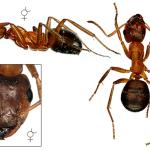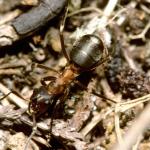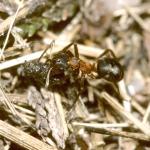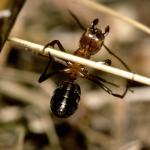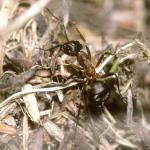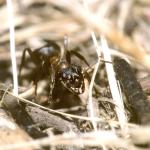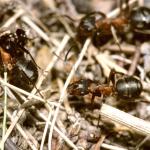Despite its generic name, this species is not classed as a wood ant.
Formica exsecta exhibits a highly disjunct population in Britain with records confined to southern England and the Scottish Highlands. In England there are two foci for these records: one stretches across the lowland heaths of Dorset (not including Purbeck), and the New Forest from Poole/Bournemouth to Ringwood and Brockenhurst, including Parkhurst Forest on the Isle of Wight. The other is centred around the lowland heaths of the Bovey Valley in east Devon with outlying records for nearby Lustleigh Cleave and for Morwenstow on the north Cornish coast. The majority of Scottish records for F. exsecta are from the Caledonian forests of the mid-Spey valley with outlying records in Easter Ross and Easterness (Highland), and around Loch Rannoch (Tayside). Recent records suggest a fairly stable population in Scotland around Loch Morlich and in Abernethy forest, and its extinction from Dorset, Hampshire and the Isle of Wight (the last record for this area was at Talbot Heath near Bournemouth in 1977). The remnant population in the Bovey Valley appears to be just viable.
Formica exsecta is listed as Rare (RDB3) in Shirt (1987) and as Endangered (RDB1) by Falk (1991). The threats to the species are many and complex but are based on the loss of habitat through destruction and inappropriate management. Examples of these may include: agricultural, industrial and urban development; afforestation of heaths and intensive timber production with few open rides and clearings; management of heath to produce a dense, single-age heather monoculture; excessive bracken and scrub encroachment over heath leading to the shading out of nests. Threats may also include the subsequent invasion of competitive species, e.g. wood ants (i.e. ants of the Formica rufa group), following habitat change. Efforts have been made to determine the 'health' and status of the populations in Devon and in Scotland (Hoare et al., 1994) in order to ensure their long-term viability.
Nests are found in fairly open heath or moor, as well as woodland rides and clearings, and roadside verges. They are often built around a grass tussock (e.g. purple moor-grass), or other supportive structure.
July to August
The nest mounds of F. exsecta are formed of vegetation fragments, like those of wood ants, but the fragments tend to be finer and the nests are usually smaller (on average about the size of half a football). They are usually in isolation but occasionally occur in small groups. The workers forage from these to low-growing shrubs and trees for aphid honeydew and also to capture or scavenge insects. New colonies are formed by colony fission or semi-social parasitism of other Formica species by newly mated queens. There may be one or more queens per colony and very large polygynous colonies have been recorded on the continent: these appear to be rare in Britain.
2021


